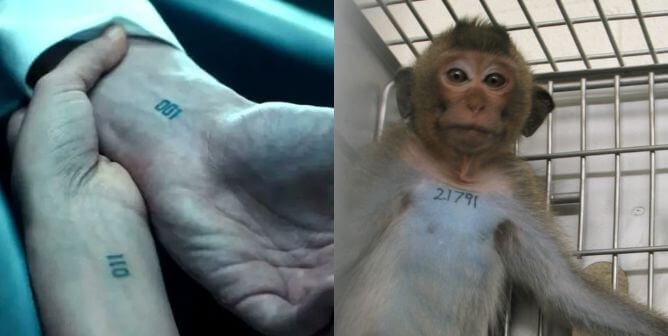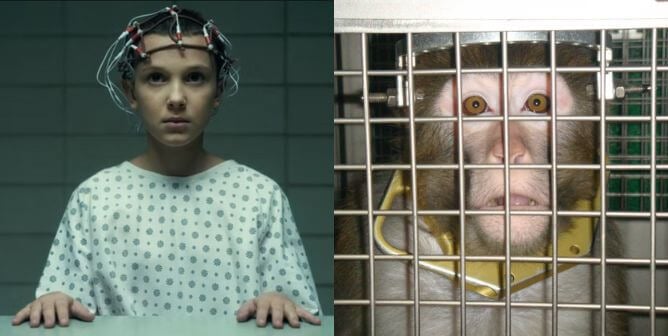How the ‘Stranger Things’ Hawkins Lab Compares With Real-Life Labs
If the experiments on human children shown in Netflix’s Stranger Things make your skin crawl, PETA has some upsetting news for you. We’ve exposed horrors in laboratories in which experimenters conduct invasive, painful tests on monkeys, mice, rats, dogs, birds, and other animals that mirror the disturbing procedures shown in the series.
If you plan on bingeing the final episodes of the fourth season of Stranger Things on July 1, first take a look at some of the similarities between the show’s fictional Hawkins National Laboratory and real-life laboratories that imprison, experiment on, and kill our fellow animals.
Experimenters Refer to Animals With a Series of Numbers
Much like Jane (or “Eleven”) and her peers at Hawkins, monkeys, dogs, and other animals imprisoned in laboratories are referred to by a series of numbers—which are crudely tattooed on their bodies, like a serial number on a product—instead of by names. Experimenters view the animals they use and kill in cruel tests as tools, not individuals with feelings, denying them even the most basic form of respect.

During PETA’s undercover investigation into the Wisconsin National Primate Research Center (WNPRC), which exposed misery, neglect, and extreme confinement of monkeys—most of whom were known only by their tattoo numbers—our eyewitness gave nicknames to some of the individuals. Princess, who was referred to by staff as rh2519, received her name to reflect her sweet-natured, gentle personality. Forced to breed over and over again, she had apparently pulled out her own hair in frustration. Experimenters then tore her babies from her for use in tests.
Laboratories Try to Keep Suffering Secret
Hawkins isn’t the only laboratory that covers up abuse and death—as PETA has revealed, universities and other institutions that conduct or fund experiments on animals will go to desperate lengths to conceal horrific cruelty to animals from the public.
During PETA’s extensive campaign that helped shut down the vile dog-breeding program at Texas A&M University’s muscular dystrophy (MD) laboratory, we called out the school for censoring Facebook and YouTube comments and even banning a man with MD from its campus. More recently, the laboratory’s lead experimenter promised that all dogs would be released for adoption when he was done with them. Dozens of them were—but nine healthy dogs were transferred to a different campus laboratory.
Experimenters Electroshock Animals
Experimenters routinely electroshock other animals in pointless tests.
In the University of Delaware’s useless “child abuse” tests, experimenters subjected infant rats to electric shocks to induce fear in the animals. Johns Hopkins University (JHU) experimenters induced depression in mice before attaching wet clips to their ears and delivering electric shocks so severe that they caused seizures.
Electrodes Are Attached to Animals’ Brains
Experimenters often use electrodes to “study” animals’ brains—but they’re nothing like the wire helmet devices used at Hawkins:

The procedure typically involves cutting into animals’ skulls and inserting electrodes into their brains.
Brain experiments on owls in Shreesh Mysore’s JHU laboratory involve cutting into owls’ skulls, inserting electrodes into their brains, forcing the animals to look at screens for hours at a time, and bombarding them with noises and lights.
Experimenters Force Animals to Do Meaningless, Confusing Tasks
Similar to the “training” exercises at Hawkins, experimenters may force animals to perform confusing tasks and punish them for expressing “undesired” behavior.
In one test, experimenters at JHU cut into monkeys’ skulls, covered their brains with a metal plate, and then made two rhesus monkeys use a computer game in which they “gambled” for “drops of juice.” (It’s common for experimenters to restrict animals’ fluid intake to coerce them to cooperate.)
Animals Are Stolen From Their Homes and Families
Kidnapping newborns from their mothers and turning them into test subjects seems like a nightmare that would only occur in horror shows, but it happens all the time in reality.
Monkeys who have been bred in captivity on squalid monkey farms are routinely snatched from their families, transported thousands of miles away to the U.S., and sold to laboratories to be tormented and killed in cruel experiments. Others are abducted from their natural homes and laundered (passed off as captive-bred) to laboratory suppliers.
Animals Are Drugged
If dosing humans with psychedelics to give them superpowers sounds absurd, imagine trying to create drugs that are effective for humans by testing them on an entirely different species. Many of these experiments are curiosity-driven—and there is virtually nothing beneficial to human patients to show for them.
At Louisiana State University (LSU), experimenter Christine Lattin’s tests on sparrows involve pumping birds with sex hormones and generating panic in them by playing the sounds of a predator. When the tests are over, she kills all the birds and dissects their brains.
*****
Help Animals Trapped in Real-Life Laboratories
Experimenters confine other animals to barren cages, socially isolate them, mutilate them, and torment them in useless tests that aren’t relevant to humans. That’s why PETA’s Research Modernization Deal (RMD) outlines a road map for replacing useless experiments on animals with modern, non-animal research methods. You can help spare animals suffering in laboratories and advance research by supporting our RMD:

